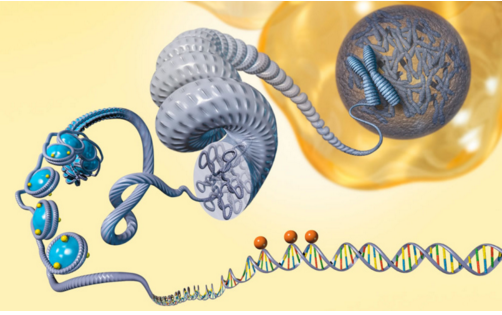|
|
Developmental Biology - Epigenetics
Turning Epigenetic Marks OFF!
Now, research has identified 2 proteins that can remove methylation marks from DNA...
Epigenetics is defined as heritable changes made to a gene. But these changes are not in the DNA sequence itself — they come from methyl groups added to the DNA strand. Now, research has identified 2 proteins that can remove methylation marks from DNA.
DNA methylation marks typically reduce the activity of surrounding genes.
Demethylation occurs when genes become re-activated.
Epigenetics play a central role in diseases in our cardiovascular system, in neurodegenerative disorders and in cancers. One of the most prominent epigenetic processes is DNA methylation, where one of the four DNA bases is marked by a recently "added" methyl group.
In a recent study published in Nature Structural and Molecular Biology, IMB scientists have identified two proteins, Neil1 and Neil2 as important for demethylating DNA.
The proteins Neil1 and Neil2 are a missing link in the chain of events that explain how DNA can be efficiently demethylated.
Lars Schomacher PhD, Institute of Molecular Biology, Mainz, Germany, and first author on the paper.
DNA demethylation is known to involve proteins also involved in DNA repair. So, epigenetic gene regulation and genome maintenance are linked. Schomacher and colleagues identified in Neil1 and Neil2 two additional repair factors that protect DNA integrity when DNA is being demethylated.
Neil Boosts Tdg - Central to DNA Demethylation.
Both Neils and Tdg are essential proteins for survival and development. Schomacher and team carried out experiments in very early frog embryos where removing either Neils or Tdg produced severe developmental problems and death before adulthood.
Failure in setting and resetting methyl marks on DNA is involved in developmental abnormalities and cancer — where cells forget what cell type they are and start to divide uncontrollably.
Understanding which proteins are responsible for DNA demethylation will help us understand more about such disease processes. And, may even provide new approaches and new treatments.
Abstract
DNA 5-methylcytosine is a dynamic epigenetic mark with important roles in development and disease. In the Tet-Tdg demethylation pathway, methylated cytosine is iteratively oxidized by Tet dioxygenases, and unmodified cytosine is restored via thymine DNA glycosylase (Tdg). Here we show that human NEIL1 and NEIL2 DNA glycosylases coordinate abasic-site processing during TET-TDG DNA demethylation. NEIL1 and NEIL2 cooperate with TDG during base excision: TDG occupies the abasic site and is displaced by NEILs, which further process the baseless sugar, thereby stimulating TDG-substrate turnover. In early Xenopus embryos, Neil2 cooperates with Tdg in removing oxidized methylcytosines and specifying neural-crest development together with Tet3. Thus, Neils function as AP lyases in the coordinated AP-site handover during oxidative DNA demethylation.
Authors
Lars Schomacher, Dandan Han, Michael U Musheev, Khelifa Arab, Sabine Kienhöfer, Annika von Seggern and Christof Niehrs.
Acknowledgements
About the Institute of Molecular Biology gGmbH
The Institute of Molecular Biology gGmbH (IMB) is a center of excellence in the life sciences that was established in 2011 on the campus of Johannes Gutenberg University Mainz (JGU). Research at IMB concentrates on three cutting-edge areas: epigenetics, developmental biology, and genome stability. The institute is a prime example of a successful collaboration between public authorities and a private foundation. The Boehringer Ingelheim Foundation has dedicated EUR 100 million for a period of ten years to cover the operating costs for research at IMB, while the state of Rhineland-Palatinate provided approximately EUR 50 million for the construction of a state-of-the-art building. For more information about IMB, please visit http://www.imb.de.
About the Boehringer Ingelheim Foundation
The Boehringer Ingelheim Foundation is an independent, non-profit organization committed to the promotion of the medical, biological, chemical, and pharmaceutical sciences. It was established in 1977 by Hubertus Liebrecht (1931-1991), a member of the shareholder family of the company Boehringer Ingelheim. With the PLUS 3 Perspectives Program and the Exploration Grants, the foundation supports independent group leaders. It also endows the internationally renowned Heinrich Wieland Prize as well as awards for up-and-coming scientists. In addition, the foundation pledged to donate EUR 100 million to finance the scientific running of the IMB at Johannes Gutenberg University Mainz for ten years. In 2013, the Boehringer Ingelheim Foundation donated a further EUR 50 million to Mainz University. For more information about the Boehringer Ingelheim Foundation, please visit http://www.boehringer-ingelheim-stiftung.de.
Return to top of page.
|
|
Jan 19, 2016 2020 Fetal Timeline Maternal Timeline News
 Illustrated is a chromosome unwound down to the DNA helix. Orange spheres are methyl groups added by processes outside our inherited DNA. Methylation can "turn off" DNA when attached. CREDIT Abhishek Sampath Kumar/ MPI
|
|



